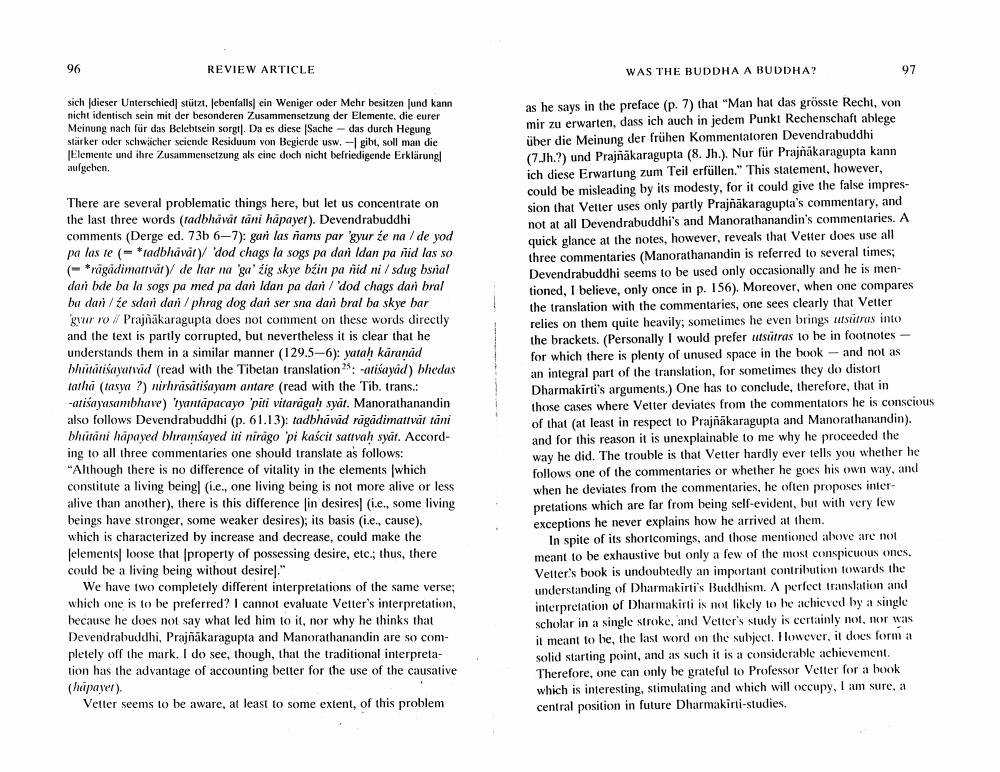Book Title: was The Buddha A Buddha Author(s): Eli Franco Publisher: Eli Franco View full book textPage 9
________________ 96 REVIEW ARTICLE WAS THE BUDDHA A BUDDHA? 97 sich dieser Unterschied stützt, lebenfalls ein Weniger oder Mehr besitzen und kann nicht identisch sein mit der besonderen Zusammensetzung der Elemente, die eurer Meinung nach für das Belehtsein sorgt). Da es diese Sache - das durch Hegung stärker oder schwacher seiende Residuum von Begierde usw. - gibt, soll man die Elemente und ihre Zusammensetzung als eine doch nicht befriedigende Erklärung aufgehen. There are several problematic things here, but let us concentrate on the last three words (radbhāvāt tani hapayer). Devendrabuddhi comments (Derge ed. 73b 6–7): gari las nams par 'gyur ze na / de yod pa las te (= *radbhavār / 'dod chags la sogs pa dari Idan pa nid las so (-*rigadimartvar / de Itar na 'ga'zig skye búin pa nid ni/sdug burial dari bde ba la sogs pa med pa dan Idan pa dan / 'dod chags dari bral ba dani/že sdan dan/phrag dog dan ser sna dan bral ba skye bar gyur ro / Prajnakaragupta does not comment on these words directly and the text is partly corrupted, but nevertheless it is clear that he understands them in a similar manner (129.5-6): patah karandid bhitationid (read with the Tibetan translations: aliśayid) bhedas tathi (tasy ?) nirhrasatiśayam antare (read with the Tib. trans.. -arisayasambhave) Tryantapacayo piti vitaragah syar. Manorathanandin also follows Devendrabuddhi (p. 61.13): tadbhavad rāgadimattvättani bhutani hapayed bliramsayed ili nirágo pi kaścit saltvah syar. Accord ing to all three commentaries one should translate as follows: "Although there is no difference of vitality in the elements (which constitute a living beingl i.e., one living being is not more alive or less alive than another), there is this difference in desires (i.e., some living beings have stronger, some weaker desires); its basis (i.e, cause), which is characterized by increase and decrease, could make the Jelements loose that property of possessing desire, etc.; thus, there could be a living being without desire]." We have two completely different interpretations of the same verse; which one is to be preferred? I cannot evaluate Vetter's interpretation, hecause he does not say what led him to it, nor why he thinks that Devendrabuddhi, Prajñākaragupta and Manorathanandin are so completely off the mark. I do see, though, that the traditional interpretation has the advantage of accounting better for the use of the causative (hapayer). Vetter seems to be aware, at least to some extent of this problem as he says in the preface (p. 7) that "Man hat das grösste Recht, von mir zu erwarten, dass ich auch in jedem Punkt Rechenschaft ablege über die Meinung der frühen Kommentatoren Devendrabuddhi (7.Jh.?) und Prajñākaragupta (8. Jh.). Nur für Prajnakaragupta kann ich diese Erwartung zum Teil erfüllen." This statement, however, could be misleading by its modesty, for it could give the false impression that Veller uses only partly Prajnakaragupta's commentary, and not at all Devendrabuddhi's and Manorathanandin's commentaries. A quick glance at the notes, however, reveals that Vetter does use all three commentaries (Manorathanandin is referred to several times; Devendrabuddhi seems to be used only occasionally and he is mentioned, I believe, only once in p. 156). Moreover, when one compares the translation with the commentaries, one sees clearly that Vetter relies on them quite heavily, sometimes he even brings uitsutrus into the brackets. (Personally I would prefer utsätras to be in footnotes - for which there is plenty of unused space in the book and not as an integral part of the translation, for sometimes they do distort Dharmakirti's arguments.) One has to conclude, therefore, that in those cases where Vetter deviates from the commentators he is conscious of that at least in respect to Prajnakaragupta and Manorathanandin). and for this reason it is unexplainable to me why he proceeded the way he did. The trouble is that Vetter hardly ever tells you whether he follows one of the commentaries or whether he goes his own way, and when he deviates from the commentaries, he often proposes interpretations which are far from being self-evident, but with very lew exceptions he never explains how he arrived at them. In spite of its shortcomings, and those mentioned above are not meant to be exhaustive but only a few of the most conspicuous ones. Vetter's book is undoubtedly an important contribution towards the understanding of Dharmakirtis Buddhism. A perfect translation and interpretation of Dharmakirti is not likely to be achieved by a single scholar in a single stroke, and Vetter's study is certainly not, nor was it meant to be, the last word on the subject. I lowever, it does forma solid starting point, and as such it is a considerable achievement Therefore, one can only be grateful to Professor Vetter for a book which is interesting, stimulating and which will occupy, I am sure, a central position in future Dharmakirti-studies.Page Navigation
1 ... 7 8 9 10
